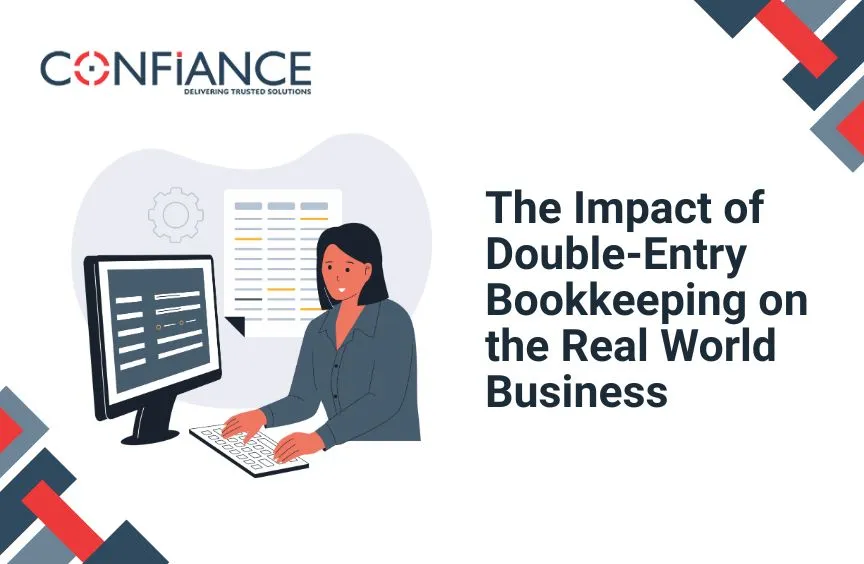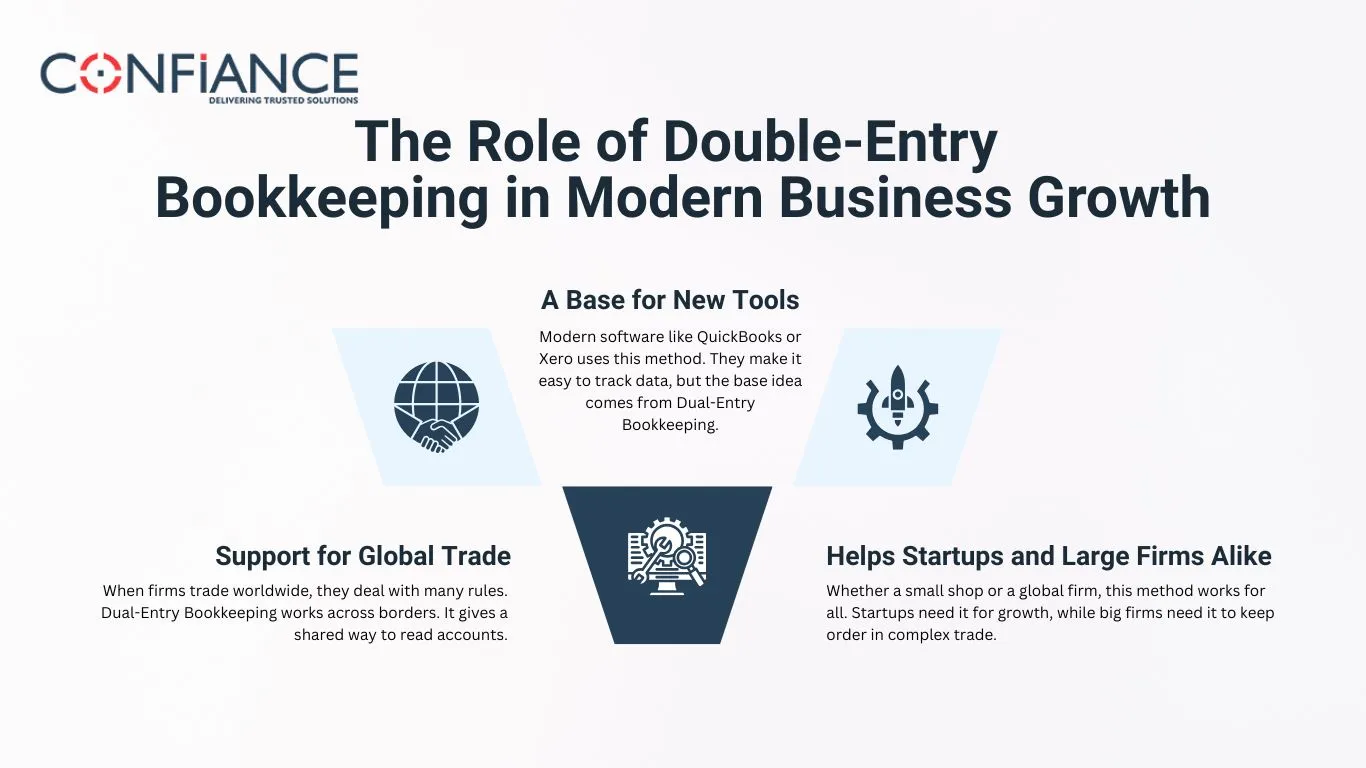
The Impact of Double-Entry Bookkeeping on the Real World Business
Double-Entry Bookkeeping is a system that records each transaction twice, which shapes the way businesses manage money today. This system makes sure that every entry has two sides: a debit and a credit. By doing this, it builds a full picture of how money moves in a business. The idea sounds simple, but the effect it has on real-world business is huge.
What is Double-Entry Bookkeeping?
Double-Entry Bookkeeping is the system where each transaction is recorded in two places. One side shows where the money came from, and the other shows where it went. This helps a business track not just income and spending but also assets and debts.
The Two Sides of Every Entry
- Debit: This shows what the business owns or spends.
- Credit: This shows what the business owes or gains.
By recording both sides, the books always balance. If they do not, then there is an error that needs fixing.
Why This Method Stands Out
Unlike single-entry records, Dual-Entry Bookkeeping gives a full view of the health of the business. It links each move of money with its source and use.
Practical Applications of Double-Entry Bookkeeping
The impact of this system on business is wide. It helps with trust, growth, and smart decisions.
Stronger Financial Clarity
With both debit and credit noted, business owners see the full story. They know where the money comes from and where it goes. This helps them plan better and avoid waste.
Builds Trust with Stakeholders
Investors, banks, and partners trust a business that uses Dual-Entry Bookkeeping. It shows that the company is serious about clear and fair records. This trust can lead to loans, support, and more deals.
A Tool for Long-Term Growth
Clear records make it easy to spot trends. A business can see which products sell more or which areas need cost cuts. This insight supports steady growth.
How Dual-Entry Bookkeeping Shapes Business Decisions
Business is not just about selling. It is about making smart choices. This system helps leaders make these choices.
Spotting Errors Early
Since the books must balance, mistakes show up fast. This saves time and prevents bigger losses.
Clear View of Profit and Loss
Owners can see what they really earn after costs. This gives them a true view of their profit and loss.
Easier Tax Compliance
With neat records, tax work becomes simple. Governments prefer businesses that keep good books, and Dual-Entry Bookkeeping makes that possible.
The Role of Double-Entry Bookkeeping in Modern Business Growth
The modern business world moves quickly, and firms need reliable systems to stay ahead.
Support for Global Trade
When firms trade worldwide, they deal with many rules. Dual-Entry Bookkeeping works across borders. It gives a shared way to read accounts.

A Base for New Tools
Modern software like QuickBooks or Xero uses this method. They make it easy to track data, but the base idea comes from Dual-Entry Bookkeeping.
Helps Startups and Large Firms Alike
Whether a small shop or a global firm, this method works for all. Startups need it for growth, while big firms need it to keep order in complex trade.
Common Myths About Dual-Entry Bookkeeping
Some think the system is too hard or old. But these are myths.
Myth 1: It Is Too Complex
At first, it may seem tricky. But once learned, it is simple and useful. Many tools today make it even easier.
Myth 2: Only for Large Companies
Even a small shop can use Dual-Entry Bookkeeping. In fact, it helps them grow by showing clear records.
Myth 3: It Is Outdated
Though the method is old, it is still the basis of all modern accounts. It has only improved with technology.
Key Advantages of Using Double-Entry Bookkeeping
Double-Entry Bookkeeping gives clear insight into how a business runs. It helps owners, investors, and even banks trust the records. Below are some key benefits of this method.
Accurate and Reliable Records
This method ensures that all money flows are tracked. Since each entry has a debit and a credit, errors show up quickly. This accuracy builds strong trust in reports and guides smart business moves.
Better Control of Finances
With balanced records, owners see where money comes from and goes. This allows them to track costs, spot leaks, and plan growth with less risk. It creates stronger control over the business.
A Foundation for Growth
Dual-Entry Bookkeeping supports growth by giving clear numbers. Investors and banks rely on it before funding a business. With this system in place, firms can plan, expand, and build trust with ease.
Double-Entry Bookkeeping vs. Single-Entry System
Many firms ask if they should use single-entry or double-entry. Below is a simple view that shows why Dual-Entry Bookkeeping works better for long-term business success.
| Feature | Double-Entry Bookkeeping | Single-Entry System |
| Accuracy | High, as each entry is checked with a matching entry | Low, as records may miss errors |
| Financial View | Full view of assets, debts, income, and spending | Limited to cash in and cash out |
| Error Detection | Easy to spot mistakes when books do not balance | Errors often remain hidden |
| Trust for Investors | Builds trust with banks, partners, and investors | Lacks detail, so less trust |
| Best For | Small and large firms that want growth and clarity | Very small shops with simple cash activity |
Double-Entry Bookkeeping and Business Growth Stories
Many firms have seen success with this method.
Small Business Success
A local store that started with a single-entry shifted to Dual-Entry Bookkeeping. They saw their waste, cut costs, and grew profit by 25% in one year.
Large Firm Growth
A global company used this system to manage trade across many lands. With clear records, they gained trust from banks and raised funds for new projects.
Challenges and Solutions in Using Double-Entry Bookkeeping
Every system has its challenges. But the good news is, there are ways to deal with them.
The Learning Curve
At first, it may take time to learn. Owners can join short courses or hire experts to guide them.
Time Needed for Records
It does take time to record each entry. But with digital tools, the process is fast and smooth.
Cost of Setup
Some think it costs more to set up. But the long-term gain from clear records is far greater than the cost.
Future of Dual-Entry Bookkeeping in Business
The system has stood strong for many years. And it is not going away.
Linked with Tech Growth
With AI and cloud tools, Dual-Entry Bookkeeping will be even stronger. It will link with data in real time and give faster results.
Part of Smart Decision Making
Firms will use it to forecast trends and plan for the future. It will not just be about records but also about strategy.
Still the Global Standard
No matter how big or small, firms worldwide will keep using this system. It is the only way to keep fair and balanced accounts.
Bookkeeping is not just about recording numbers. It is about building a strong base for every business move. Choosing the right partner for this task can make the difference between steady growth and daily struggle. Confinace stands out because it blends skill, trust, and modern tools to keep your books in order.
At Confiance, our team is made up of trained experts who know the value of accurate records. With skilled experts and years of experience, Confinace ensures accurate records through Double-Entry Bookkeeping while guiding owners to make smart financial choices. Each service is tailored to match the size and goals of your company, whether it’s a small shop or a large firm. By using modern cloud tools, we deliver fast, error-free records and real-time reports that bring clarity. More than just keeping books, we help build trust with investors and banks, giving your business the right base for steady growth.
FAQs
- What is Double-Entry Bookkeeping?
Dual-Entry Bookkeeping is a method where each deal has two entries: debit and credit. This system keeps accounts balanced, shows where money comes from, and where it goes, giving full financial clarity.
- Why is Double-Entry Bookkeeping better than single-entry?
Dual-Entry Bookkeeping gives a full picture of assets, debts, costs, and gains. Single-entry only shows cash flow. With double-entry, errors are spotted early, and investors trust the records more for growth plans.
- Is Double-Entry Bookkeeping hard for small businesses?
No. With digital tools and expert support, even small shops can use Dual-Entry Bookkeeping. It may take a little time to learn, but it helps owners control money and plan better.
- How does Dual-Entry Bookkeeping help with taxes?
It makes tax filing easier by keeping records neat and balanced. Since every entry matches, reports are accurate. This helps firms follow rules, avoid fines, and keep trust with tax bodies.
- Can Dual-Entry Bookkeeping work with accounting software?
Yes. Modern tools like QuickBooks and Xero use this system as their base. They make recording fast, reduce mistakes, and give reports that help owners track growth in real time.
- Does every company need Dual-Entry Bookkeeping?
Yes. From small shops to global firms, every company gains from it. It is not just for large firms. Even startups need it to grow, attract funds, and keep clear records.
